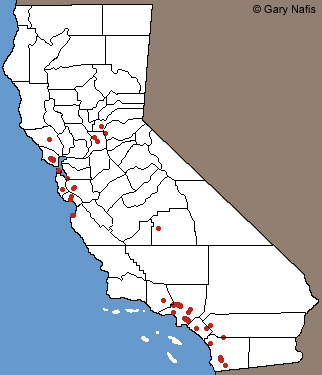|
 |
 |
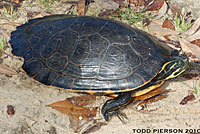 |
Adult Eastern River Cooter, Hannover Germany © NasserHalaweh 2010
Used under license CC BY-SA 4.0
(Copyright was added. Image was cropped for close-up and thumbnails.) |
Adult, Georgia © Todd Pierson 2011
Used under license CC BU-NC 3.0.
(Image was cropped and re-sized for thumbnail.) |
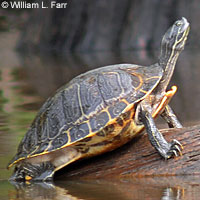 |
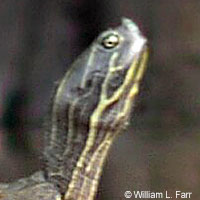 |
|
Adult, Marion County, Texas © William L. Farr
Used under the Creative Commons Attribution-Share Alike 4.0 International license
(Copyright was added. Image was cropped and re-sized for thumbnails.) |
|
| |
|
|
|
Description |
| |
| Size |
Adults average 9-13 inches (23-33 cm) with a record of 14.75 inches (37.5 cm). (Powell et al 2016)
(Ernst et al, 2009, report a record carapace of 43.7 cm [17.2 inches. Hansen & Shedd, 2025, report a maximum size of 15.6 inches (397 cm).
Hatchlings are about 1.5 inches (4 cm) in diameter and have brighter green shells with brighter markings than adults.
|
| Appearance |
A large aquatic turtle. Skin is olive to brown in color with light yellow to cream-colored stripes.
The dark carapace is oval to elongated in shape, highest in the middle, with a pattern of light markings.
The posterior of the carapace is slightly serrated.
Light C-shaped marks are found on the second pleurals. The C mark may face forwards or backwards. (Powell et al 2016)
The undersides of all or most of the marginals have dark spots, which are usually doughnut-shaped.
There are 5 light stripes between the eyes.
"On the head the narrow supratemporal and paramedial stripes lie parallel and the sagittal stripe passes anteriorly between the eyes but does not meet the supratemporals." (Ernst et al 2009)
Many older turtles become melanistic, obscuring the head markings. The carapace may also be covered with a dark stain that obscures the light pattern.
Male/Female differences
Adult males have elongated straight foreclaws and long thick tails.
Females are larger than males and have more domed carapaces.
|
| Life History and Behaviors |
Diurnal.
A freshwater turtle that is often seen basking in the sun on logs and rocks, often with other aquatic turtles.
Quickly slips into the water when disturbed.
Large webbed feet make River Cooters strong swimmers, able to negotiate strong river currents.
Sometimes wanders from one body of water to another.
Sleeps in the water, hidden under vegetation.
Remains active all year in warm areas, but becomes dormant during cold temperature, burying itself in mud, slowing down its metabolism and taking in oxygen from the water through its cloaca.
|
| Diet |
Omnivorous, eating whtever food items are available, including aquatic and terrestrial plants, invertebrates, fish, tadpoles, freshwater sponges, snails, clams, crayfish and carrion.
Cannot swallow food out of the water. |
| Reproduction and Young |
In the natural range, mating takes place in the early Spring with nesting taking place from May to June.
Females move onto land to find a nesting site with loose soil not too far from the river's edge and lays from 12 to 20 eggs.
Females lay 9-29 eggs in nests in open areas within 30 meters of water.
Eggs incubated in a laboratory hatched after 84-92 days. (Ernst et al 2009)
Late hatchlings sometimes remain in the nest cavity through their first winter and emerge the following spring.
|
| Habitat |
Inhabits rivers, lakes, ponds, brackish tidal marshes.
Usually found in rivers with a modeate current.
Rarely seen out of the water except when basking or when females are nesting on land.
"In CA, has been observed in artificial lakes and ponds, where it favors open-water basking sites. Usually greatly outnumbered by Red-eared Slider but sometimes seen basking next to that species." (Hansen & Shedd 2025)
|
| Geographical Range |
Natural Range
Found in southeastern North America from Virginia to the Gulf of Mexico, east Texas, and north into southern Illinois and Indiana.
Introductions
Introduced in California, around the Puget Sound in Washington, Vancouver and Vancouver Island in Canada, Las Vegas, southern Texas, Phoenix and Tucson. It has also spread into many locations north of its natural range, including Chicago, Detroit, Cleveland, Cincinnati, and north from Virginia through Maryland, New Jersey, Pennsylvania, and New York.
Distribution in California
"In CA, most ovservations have been made at low elevations near densely populated areas: Sacramento, San Francisco Bay Area/San Jose, Los Angeles Basin, and San Diego Co. Although multiple turtles have been observed at some of these sites, there is no evidence to suggest presence of breeding populations except at Otay Lake, San Diego Co."
(Hansen & Shedd 2025)
|
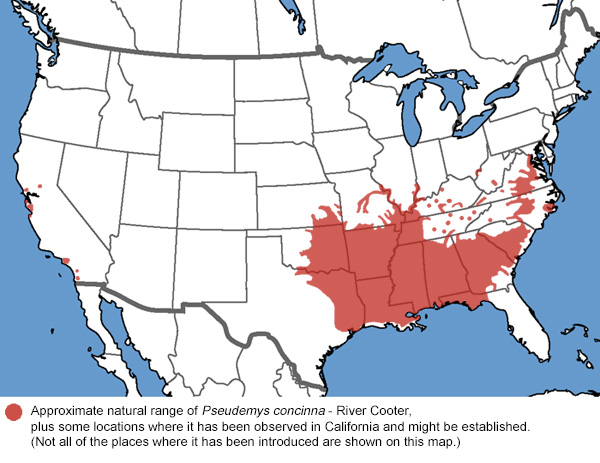
|
| Taxonomic Notes |
Two subspecies are currently recognized:
* Pseudemys concinna concinna (LeConte, 1830) – Eastern River Cooter
* Pseudemys concinna suwanniensis Carr, 1937 – Suwannee Cooter
(Suwannee Cooter is sometimes regarded as a separate species, Pseudemys. suwanniensis.
Some current and former subspecies names:
Pseudemys concinna concinna - Eastern River Cooter
Pseudemys concinna suwanniensis - Suwannee River Cooter
Pseudemys concinna metteri
Pseudemys concinna hieroglyphica
Pseudemys concinna mobilensis
The Coastal Plain Cooter or Florida Cooter (Pseudemys floridana) was formerly considered a subspecies of Pseudemys concinna, and is now considered a distinct species.
Alternate and Previous Names (Synonyms)
Testudo concinna
Emys concinna
Chrysemys concinna
(See the Reptile Database for a long list of synonyms.)
|
| Conservation Issues (Conservation Status) |
River Cooters are sold as pets, but few live to adulthood in captivity. Those that do are often released by owners who cannot provide a large enough enclosure for them or can't satisfy their other needs or who did not know that they can live a long time in captivity and get tired of keeping them. River Cooters can negatively impact local ecosystems by competing for resources with the native pond turtles and creating significant conservation concerns.
"This is one of several species of non-native turtles that have become established in CA following illegal release of captives. Extreme wariness and tendency to favor basking sites often at great distance from land-bound human observers suggest that P. concinna might be underrepresented in community-science databases. Good binoculars and a telephoto lens are useful in locating, identifying, and documenting new records. Although it is currently thought to be reproducing at only one site, this species may become established elsewhere, especially valuable are reports of juveniles or nesting females." (Hansen & Shedd, 2025)
|
|
Taxonomy |
| Family |
Emydidae |
Box and Water or Pond Turtles |
Gray, 1825 |
| Genus |
Pseudemys |
Redbelly Turtles and Cooters |
Gray, 1856 |
Species
|
concinna |
River Cooter |
(Le Conte, 1830) |
|
Pseudemys concinna (Le Conte, 1830) - Ann. Lyc. Nat. Hist. New York, Vol. 3, p. 106
from Original Description Citations for the Reptiles and Amphibians of North America © Ellin Beltz
|
Meaning of the Scientific Name
|
Pseudemys - Greek - pseudes = false, deceptive and Greek - emys turtle — refers to this not being Emys.
Concinna - Latin = symmetrical, neatly arranged — refers to the arrangement of markings on the upper shell.
from Scientific and Common Names of the Reptiles and Amphibians of North America - Explained © Ellin Beltz
|
Related or Similar California Herps
|
Other similar species of Pseudemys (Cooters) are sometimes observed in Califorrnia but none are known to be established and breeding, yet.
A. marmorata - Northwestern Pond Turtle
A. pallida - Southwestern Pond Turtle
C. p. bellii - Western Painted Turtle
S. odoratus - Eastern Musk Turtle
T. s. elegans - Red-eared Slider
T. s. scripta - Yellow-bellied Slider
|
More Information and References
|
California Department of Fish and Wildlife
iNaturalist
The Reptile Database
IUCN Redlist
Hansen, Robert W. and Shedd, Jackson D. California Amphibians and Reptiles. (Princeton Field Guides.) Princeton University Press, 2025.
Nicholson, K. E. (ed.). 2025. Scientific and Standard English Names of Amphibians and Reptiles of North America North of Mexico, with Comments Regarding Confidence in Our Understanding. Ninth Edition. Society for the Study of Amphibians and Reptiles. [SSAR] 87pp.
Robert Powell, Roger Conant, and Joseph T. Collins. Peterson Field Guide to Reptiles and Amphibians of Eastern and Central North America. Fourth Edition. Houghton Mifflin Harcourt, 2016.
Powell, Robert., Joseph T. Collins, and Errol D. Hooper Jr. A Key to Amphibians and Reptiles of the Continental United States and Canada. The University Press of Kansas, 1998.
Carr, Archie. Handbook of Turtles: The Turtles of the United States, Canada, and Baja California. Cornell University Press, 1969.
Ernst, Carl H., Roger W. Barbour, & Jeffrey E. Lovich. Turtles of the United States and Canada. Smithsonian Institution 1994.
(2nd Edition published 2009)
|
|
|
The following conservation status listings for this animal are taken from the July 2025 State of California Special Animals List and the July 2025 Federally Listed Endangered and Threatened Animals of California list (unless indicated otherwise below.) Both lists are produced by multiple agencies every year, and sometimes more than once per year, so the conservation status listing information found below might not be from the most recent lists, but they don't change a great deal from year to year.. To make sure you are seeing the most recent listings, go to this California Department of Fish and Wildlife web page where you can search for and download both lists:
https://www.wildlife.ca.gov/Data/CNDDB/Plants-and-Animals.
A detailed explanation of the meaning of the status listing symbols can be found at the beginning of the two lists. For quick reference, I have included them on my Special Status Information page.
If no status is listed here, the animal is not included on either list. This most likely indicates that there are no serious conservation concerns for the animal. To find out more about an animal's status you can also go to the NatureServe and IUCN websites to check their rankings.
Check the current California Department of Fish and Wildlife sport fishing regulations to find out if this animal can be legally pursued and handled or collected with possession of a current fishing license. You can also look at the summary of the sport fishing regulations as they apply only to reptiles and amphibians that has been made for this website.
This animal is not included on the Special Animals List, which indicates that there are no significant conservation concerns for it in California. The IUCN and Natureserve rankings for the species throughout its range show that it is not threatened.
|
| Organization |
Status Listing |
Notes |
| NatureServe Global Ranking |
G5 |
Secure |
| NatureServe State Ranking |
|
|
| U.S. Endangered Species Act (ESA) |
|
|
| California Endangered Species Act (CESA) |
|
|
| California Department of Fish and Wildlife |
|
|
| Bureau of Land Management |
|
|
| USDA Forest Service |
|
|
| IUCN |
LC |
Least Concern |
|
|
